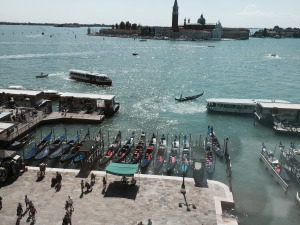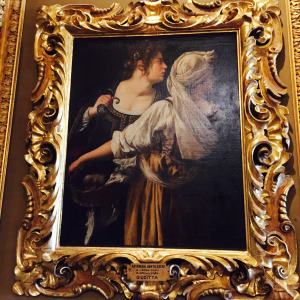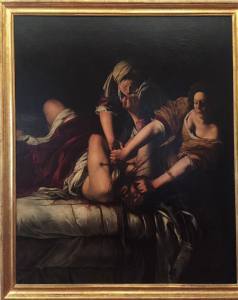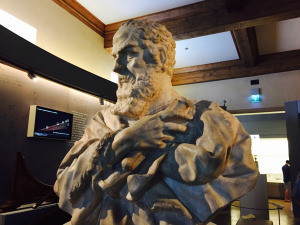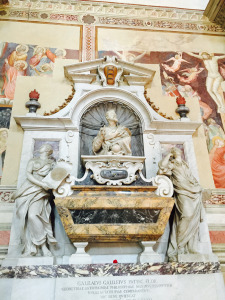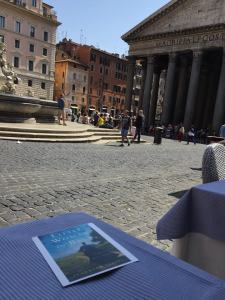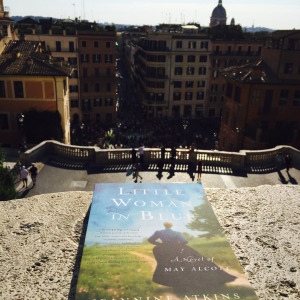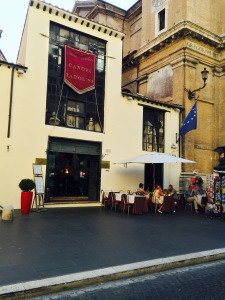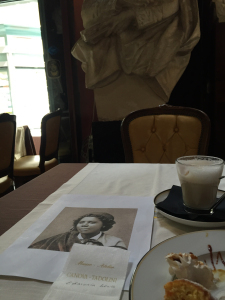Women and Art in Florence and Rome
My daughter and I are back from a great trip to Italy where we walked a lot, ate a lot, and visited a lot of museums. I loved my first ever gondola ride in Venice, a wine tour in Tuscany, and learning from my favorite art history major about Renaissance and Baroque art, though I’m usually looking for the women. Venice with its lovely boats and waterways was a bust in this respect. The Accademi Galleries is supposed to hold pastel portraits by late Baroque artist Rosalba Carriera, but there was construction underway, and maybe they were temporarily in storage.
We did a bit better in Florence, seeing work by Artemisia Gentileschi (1593-1656), who is featured in books about women artists and novels including Susan Vreeland’s The Passion of Artemisia. She was inspired by Caravaggio, whose work was well-represented in many churches and museums, though Emily told me that he was a bit of an outcast in his day, with some patrons objecting to things like how he painted holy men with realistically dirty feet. We saw Judith and her Maidservant at the Pitti Palace.
And Judith Slaying Holofernes at the Uffizi Gallery. This is thought to have been painted for Cosimo II de’Medici, but because of its violence was put in a dark corner (though the Medici family knew plenty about violence, and this theme wasn’t uncommon). Artemisia Gentileschi wasn’t paid for this work, until her friend Galileo Galilei, who wanted to be an artist before he began focusing on science, came to her aid.
This makes me fond of Galileo, though he’s better known for making telescopes that changed his and our view of not only the sky, but the cosmos.
He saw that Venus had phases like the moon, which showed it rotated around the sun. The moons he observed around Jupiter did not circle the earth. It looked like the earth wasn’t at the center of the universe, a point that got him called a heretic by the church and put under house arrest for almost twenty years. About 100 years later, the Catholic Church admitted Galileo had a point, had his body dug up and buried under lovely tomb in the Basilica of Santa Croce.
Sometimes you have to bring along your own signs of artists. May Alcott studied lots of paintings and sculptures in Rome in 1870. I let her enjoy lunch outside the Pantheon, which includes the tomb of Raphael, one of her favorite painters.
I escorted her to the Spanish Steps, where back in the day artists gathered in the morning, often choosing models who sat there or around the Bernini fountain.
Nearby, a street of houses with big doors that once let in big chunks of marble and let out statues is now filled with swanky shops. I ordered cake and a latte in a restaurant in what may or may not have been Edmonia Lewis’s studio.
May-or-may-not is a theme in her story. We know she worked in a studio where Canova worked, as he did here, and then the Tadolini family, whose work is displayed. I added Edmonia Lewis’s name on my napkin and signed it in the guest book. Because one thing Rome has besides layered history is ghosts.
I wove some of my knowledge of and questions about this sculptor into Stone Mirrors, a verse history to be published by Atheneum in 2017. For those who want facts now, Harry and Albert Henderson’s excellent biography is available as an e-book. Edmonia Lewis was the first person of color to receive international acclaim as a sculptor against odds that haven’t changed enough over the past 150 years or so. According to those fabulous researchers who call themselves the Guerrilla Girls, in most major museums, only about 4% of the art on display has been made my women. And so now I’m back on the porch, jet-lagged and doing laundry, writing by asters and hydrangeas.



